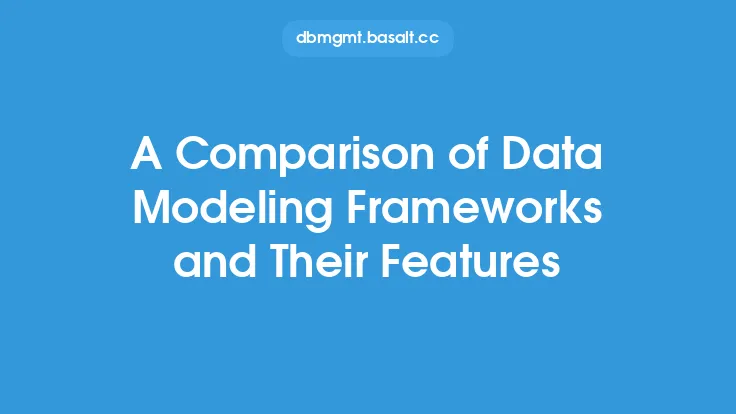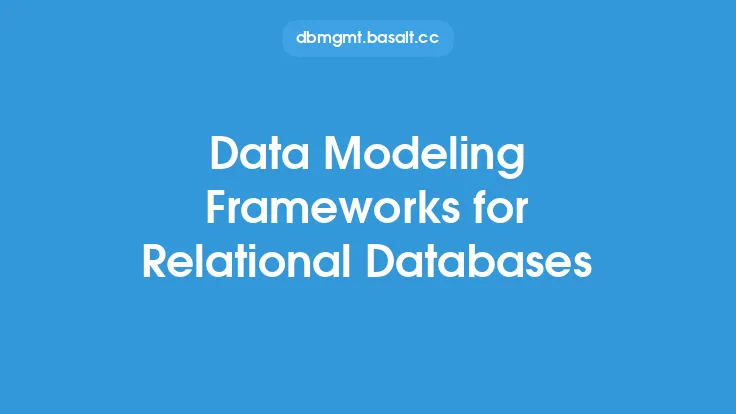Data modeling frameworks are essential tools for designing, implementing, and managing databases. These frameworks provide a structured approach to data modeling, enabling developers to create robust, scalable, and maintainable databases. With numerous data modeling frameworks available, each with its strengths and weaknesses, it's crucial to understand the popular ones and their characteristics.
History and Evolution of Data Modeling Frameworks
The concept of data modeling frameworks has been around for several decades. The earliest frameworks were developed in the 1970s and 1980s, with the introduction of Entity-Relationship (ER) modeling and relational databases. These early frameworks focused on supporting the design of relational databases and provided basic features such as entity-relationship diagrams and data normalization. Over time, data modeling frameworks have evolved to support various database management systems, including object-oriented, object-relational, and NoSQL databases. The evolution of data modeling frameworks has been driven by the need for more flexible, scalable, and efficient data management solutions.
Key Components of Data Modeling Frameworks
A data modeling framework typically consists of several key components, including:
- Data Modeling Language: A data modeling language is used to define the structure and relationships of data entities. Popular data modeling languages include Entity-Relationship (ER), Object-Role Modeling (ORM), and Unified Modeling Language (UML).
- Data Modeling Tools: Data modeling tools provide a graphical interface for creating, editing, and managing data models. These tools often include features such as entity-relationship diagrams, data normalization, and data transformation.
- Metadata Management: Metadata management is critical in data modeling frameworks, as it enables the storage, retrieval, and management of metadata associated with data entities.
- Data Transformation and Mapping: Data transformation and mapping are essential components of data modeling frameworks, as they enable the conversion of data from one format to another and the mapping of data entities to physical storage devices.
Popular Data Modeling Frameworks
Several popular data modeling frameworks are widely used in the industry, including:
- Entity-Relationship (ER) Modeling: ER modeling is a traditional data modeling framework that uses entities, attributes, and relationships to represent data structures.
- Object-Role Modeling (ORM): ORM is a data modeling framework that uses objects, roles, and relationships to represent data structures.
- Unified Modeling Language (UML): UML is a standardized data modeling language that provides a comprehensive set of features for modeling complex systems.
- Dimensional Modeling: Dimensional modeling is a data modeling framework that uses facts, dimensions, and measures to represent data structures, particularly in data warehousing and business intelligence applications.
- Data Vault Modeling: Data vault modeling is a data modeling framework that uses hubs, satellites, and links to represent data structures, particularly in data warehousing and business intelligence applications.
Data Modeling Frameworks and Database Management Systems
Data modeling frameworks are often closely tied to specific database management systems (DBMS). For example:
- Relational Database Management Systems (RDBMS): ER modeling and relational databases are closely related, as ER modeling is used to design relational databases.
- Object-Oriented Database Management Systems (OODBMS): ORM and object-oriented databases are closely related, as ORM is used to design object-oriented databases.
- NoSQL Database Management Systems: NoSQL databases often use specialized data modeling frameworks, such as document-oriented or graph-oriented modeling.
Benefits and Challenges of Data Modeling Frameworks
Data modeling frameworks offer several benefits, including:
- Improved Data Consistency and Integrity: Data modeling frameworks help ensure data consistency and integrity by providing a structured approach to data modeling.
- Increased Productivity: Data modeling frameworks can increase productivity by providing a set of pre-defined features and tools for data modeling.
- Better Data Management: Data modeling frameworks enable better data management by providing a comprehensive set of features for data modeling, transformation, and mapping.
However, data modeling frameworks also present several challenges, including:
- Steep Learning Curve: Data modeling frameworks can be complex and require a significant amount of time and effort to learn.
- Limited Flexibility: Data modeling frameworks can be inflexible, making it difficult to adapt to changing requirements or new technologies.
- High Cost: Some data modeling frameworks can be expensive, particularly those that require specialized software or hardware.
Best Practices for Using Data Modeling Frameworks
To get the most out of data modeling frameworks, follow these best practices:
- Choose the Right Framework: Select a data modeling framework that aligns with your project requirements and database management system.
- Use a Structured Approach: Use a structured approach to data modeling, including entity-relationship diagrams, data normalization, and data transformation.
- Document Your Data Model: Document your data model thoroughly, including entity descriptions, attribute definitions, and relationship explanations.
- Test and Refine Your Data Model: Test and refine your data model regularly, using data modeling tools and techniques to ensure data consistency and integrity.
Future of Data Modeling Frameworks
The future of data modeling frameworks is likely to be shaped by emerging trends and technologies, including:
- Big Data and Analytics: The increasing demand for big data and analytics will drive the development of new data modeling frameworks that support large-scale data processing and analysis.
- Cloud Computing: The growth of cloud computing will lead to the development of cloud-based data modeling frameworks that provide scalability, flexibility, and cost-effectiveness.
- Artificial Intelligence and Machine Learning: The integration of artificial intelligence and machine learning into data modeling frameworks will enable more automated and intelligent data modeling, transformation, and mapping.
As data modeling frameworks continue to evolve, they will play an increasingly important role in supporting the design, implementation, and management of databases, and will remain a critical component of data management solutions.





